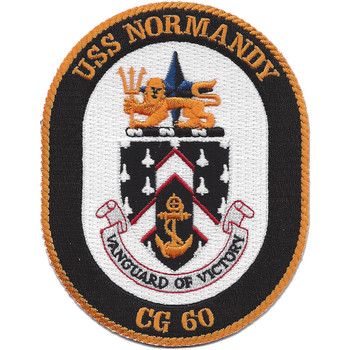Description
MC GROGAN'S US NAVY SHIPS THE USS VELLA GULF CG-72 PATCH Vella Gulf is sponsored by Mrs. Mary Ann McCauley and was commissioned into the Naval Service on 18 September 1993 in ceremonies at Norfolk, VA. Vella Gulf is a Ticonderoga Class Aegis guided missile cruiser, equipped with the most advanced technology and weaponry ever put to sea. A multi-mission ship, Vella Gulf is capable of sustained combat operations in any combination of Anti-Air, Anti-Submarine, Anti-Surface, and Strike warfare environments. She is built to fight and win, in any theater of operations, on her own terms. Vella Gulf can expect to be employed in support of carrier battle groups, amphibious assault groups, as well as in interdiction and escort missions. Vella Gulf's diverse combat capability is orchestrated by the Aegis Weapon System, the only fully integrated electronic detection, engagement, and fire control system in the world today. Aegis enables Vella Gulf to detect, evaluate, and engage an enemy with great firepower and accuracy of any combat system. Aegis showcases the AN/SPY-1B (SPY) Phased Array Radar System. SPY sends precise beams of electromagnetic energy in all directions providing a continuous search and track capability against hundreds of targets to ranges beyond 200 miles. Aegis also incorporates an antisubmarine warfare suite is equally unmatched. The AN/SQS-53C hull mounted sonar, acoustic towed array, and two SH-60B Seahawk helicopters produce underwater detection and prosecution capabilities at extended ranges. Vella Gulf's weapons include SM-2 surface-to-air missiles, Harpoon anti-ship missiles, Tomahawk cruise missiles, torpedoes, Phalanx Close-in Weapons Systems for self-defense against aircraft and missiles, and five-inch, rapid fire guns. These weapons are supplemented by electronic warfare countermeasures, decoys, and passive detection systems. Four powerful gas turbine engines propel Vella Gulf to speeds greater than 30 knots with ease.Two controllable-reversible pitch propellers assist in her rapid acceleration and maneuverability. The USS Vella Gulf successfully completed Sea Trials during the month of February 1998. In the months of May and June, the Vella Gulf completed a two month BALTOPS Cruise, taking part in the 26th annual maritime exercise U.S. Baltic Operations (BALTOPS) '98 in the Western Baltic Sea from June 8-19, 1998. During the exercise, the commander, Carrier Group Eight, commanded the exercise from the guided missile cruiser USS Vella Gulf (CG 72). The cruise was an opportunity to work with foreign military units and show presence in ports that no Navy vessel had been to before. In November, the Vella Gulf completed an AMMO onload, LAMPS moved aboard, completed a successful C2X, and had made a port call at St. John, U. S. Virgin Island. Upon the completion of C2X, the Vella Gulf continued pre-deployment work-ups. In January 1999, after winning her fifth consecutive "Battle E", Vella Gulf performed Tomahawk Launch Area Coordinator duties during Tomahawk training exercises and had the AEGIS training and readiness center onboard for a week of Force Air Defense Commander training Vella Gulf's successful completion, in February 1999, of JTFEX '99 marked the end of a ten-month work-up. The vessel headed out for deployment to the Adriatic Sea on 26 March 1999. After a six-day transit, the Vella Gulf took her position in the Adriatic Sea and participated in everything from Tomahawk Strike Ops to Fast-track Logistics Ops as part of Operation Noble Anvil. In May and June, the Vella Gulf continued to participate in support of combat operations, shot Tomahawks, assumed warfare commander duties (ADC, ASUWC, ASWC and Launch Area Coordinator), and conducted numerous at-sea refueling and stores replenishment events until the relaxation of weapons posture and cessation of hostilities. Vella Gulf began the month of August engaged in multi-ship exercises. She Participated in DIVTACS, LeapFrogs, Tomahawk exercises, submarine exercises, Flight Ops, and Gunnery exercises. The Vella Gulf returned home on 22 September 1999 and went in November to York town, VA for a complete weapons offload. As part of the USS George Washington (CVN 73) Carrier Battle Group (CVBG), and in response to the terrorist attacks of September 11, 2001, the USS Vella Gulf set sail in support of defense and humanitarian efforts off the coast of New York. The Vella Gulf deployed on September 19, 2001, as part of the Theodore Roosevelt Carrier Battle Group, to the Mediterranean, and "to points East" in support of Operation Enduring Freedom. The Roosevelt Carrier Battle Group transited the Suez Canal on October 13th and arrived in the Arabian Sea on October 15th, before returning home in April 2002. Vella Gulf Vella Gulf is named for the Battle of Vella Gulf, a naval engagement in the Solomons campaign of World War II. This engagement was historically significant because it was the first time that destroyers were allowed to operate independent of the cruiser force during the Pacific campaign. The battle was fought between the islands of Vella Lavella and Kolombangara on the night of 6 August 1943. In the battle of Vella Gulf, six American destroyers - DUNLAP (DD 394), CRAVEN (DD 392), MAURY (DD 401), LANG (DD 399), STERTT (DD 407), and STACK (DD 406) - engaged a group of four enemy destroyers attempting to reinforce Japanese troops on Kolombangara. The American warships closed the enemy undetected with the aid of radar and fired torpedoes which sank HAGIKAZE, ARASHI, and KAWKAZE with no damage to our ships. This ship is the second named for the battle of Vella Gulf. The first USS Vella Gulf was an escort carrier (CVE 111) commissioned on 9 April 1945 with CAPT Robert W. Morse in command. A COMMENCEMENT BAY class carrier, she displaced 11,373 tons, carried 34 aircraft, and held a complement of 1,066 men. Vella Gulf won a battle star for air strikes against Rots and the Pagan Islands in the Marianas in July 1945 and then participated with occupying forces after the surrender of Japan. CVE 111 was deactivated and decommissioned on 9 August 1946.
View AllClose






